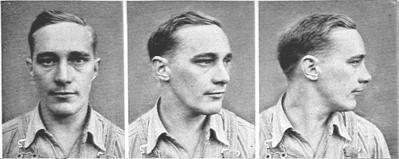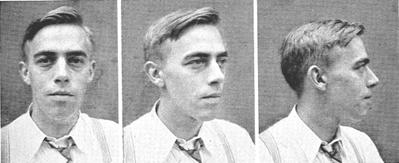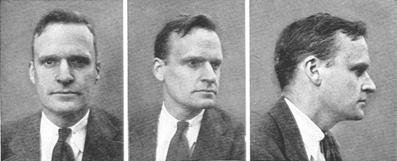|
(Photographic Supplement, Plate 27)
The Nordic race is a partially depigmented branch of the greater
Mediterranean racial stock. It is probably a composite race made up of two
or more basic Mediterranean strains, depigmented separately or in
conjunction by a progressive evolutionary process. As has been demonstrated
on plates 9 and 10, it is impossible, as some European anthropologists
believe, to derive a Nordic directly from a dolichocephalic Upper
Palaeolithic ancestor of Brünn or Crô-Magnon type. Reduction of these
overgrown races produces a result which is quite un-Nordic morphologically
as well as in constitutional type. It is the author's thesis that the Nordic
race in Europe was caused by a blending of the early Danubian Mediterranean
strain with the later Corded element. At the present time both Corded and
Danubian elements may be isolated, while other Nordics preserve the blended
form. Nordics in eastern Europe, Asia, and North Africa may have been formed
by separate recombinations or simple depigmentations of comparable
Mediterranean strains, or by invasions of these regions from an European or
West Asiatic depigmentation center.
FIG. 2 (3 views). A Swede from Sonderhamn who represents the same type, and who is very similar in most dimensions. The population of most of Sweden is predominantly Nordic; typical Upper Palaeolithic survivors are numerous only along the southwestern coast.
FIG. 3 (3 views). A Nordic Dane of Jutish parentage who also shows Corded predominance. His face is of extreme length, a trait common among ancient Corded crania. This individual is the son of the classic Borreby man shown on Plate 5, Fig. 1; this is graphic evidence of the fact that ancient racial types may be repeated in toto in individuals of mixed racial ancestry. Only through the agency of such segregation is it possible to present this collection of basic European racial photographs.
FIG. 4 (3 views). New Englander of Colonial British descent. This tall, slenderly built, ash-blond-haired Nordic is an extreme example of the Corded type which entered Britain first during the Bronze Age in conjunction with brachycephals, and later during the Iron Age as an element in the Nordic invading groups. Its presence in New England in 1938 can only be regarded as a complete reëmergence.
|



